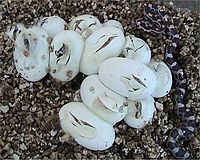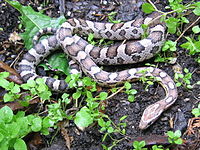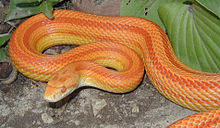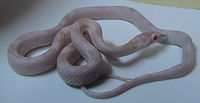- Corn Snake
-
Corn Snake 
Conservation status Scientific classification Kingdom: Animalia Phylum: Chordata Class: Diapsida Subclass: Lepidosauria Order: Squamata Suborder: Serpentes Family: Colubridae Genus: Pantherophis Species: P. guttatus Binomial name Pantherophis guttatus
(Linnaeus, 1766)Synonyms Coluber guttatus
Linnaeus,1766Elaphe guttata
(Linnaeus, 1766)The Corn Snake (Pantherophis guttatus), or Red Rat Snake, is a North American species of Rat Snake that subdues its small prey by constriction. The name "Corn Snake" is a holdover from the days when southern farmers stored harvested ears of corn in a wood frame or log building called a crib. Rats and mice came to the corn crib to feed on the corn, and Corn Snakes came to feed on the rodents.[1] The Oxford English Dictionary cites this usage as far back as 1676. Corn Snakes are found throughout the southeastern and central United States. Their docile nature, reluctance to bite, moderate adult size 3.9–5.9 feet (1.2–1.8 m), attractive pattern, and comparatively simple care make them popular pet snakes. In the wild, they usually live around 6–8 years, but in captivity can live to be up to 23 years old.[2]
Contents
Taxonomy
There are two subspecies of Pantherophis guttatus:
- The Corn Snake (Pantherophis guttatus guttatus) lives in the southeastern United States, and is distinguished by having brownish-orange skin with orange/red saddles, the saddles having black borders, and usually a black and white underbelly. However, in captivity, they can be other colours such as black and white.
- The Great Plains Rat Snake or Emory's Rat Snake (Pantherophis guttatus emoryi) is found in the United States from Nebraska to Texas, and into northern Mexico.
It has been suggested that Pantherophis guttatus be split into three species: Pantherophis guttatus, Pantherophis emoryi (corresponding with the subspecies Pantherophis guttatus emoryi) and Pantherophis slowinskii (occurring in western Louisiana and adjacent Texas).[3]
Pantherophis guttatus was previously placed in the genus Elaphe, but Elaphe was found to be paraphyletic by Utiger et al., leading to placement of this species in the genus Pantherophis.[4] The placement of Pantherophis guttatus and several related species in Pantherophis rather than Elaphe has been confirmed by further phylogenetic studies.[5][6]
Natural habitat
Wild Corn Snakes prefer habitats such as overgrown fields, forest openings, trees, palmetto flatwoods and abandoned or seldom-used buildings and farms, from sea level to as high as 6,000 feet. Typically, these snakes remain on the ground, but can ascend trees, cliffs and other elevated surfaces.[7] They can be found in the southeastern United States ranging from New Jersey to the Florida keys and as far west as Texas.
In colder regions, snakes hibernate during winter. However, in the more temperate
Reproduction
Corn snakes are relatively easy to breed. First they have to go through a cooling (also know as brumation) period that takes usually 60-90 days long. This is to get them ready for breeding and to tell them that its time to reproduce. Corns brumate at around 50-60 degrees F in a place where they can not get disturbed and not worry about predators. When its summer they go out to warm up to their regular temperature.
Corn Snakes usually breed shortly after the winter cooling. The male courts the female primarily with tactile and chemical cues, then everts one of his hemipenes, inserts it into the female, and ejaculates his sperm. If the female is ovulating, the eggs will be fertilized, and she will begin sequestering nutrients into the eggs, then secreting a shell.
Egg-laying occurs slightly more than a month after mating, with 12–24 eggs deposited into a warm, moist, hidden location. Once laid the adult snake abandons the eggs and does not return to them. The eggs are oblong with a leathery, flexible shell. Approximately 10 weeks after laying, the young snakes use a specialized scale called an egg tooth to slice slits in the egg shell, from which they emerge at about 5 inches in length.
Variations
After many generations of selective breeding, domesticated Corn Snakes are found in a wide variety of different colors and patterns. These result from recombining the dominant and recessive genes that code for proteins involved in chromatophore development, maintenance, or function. New variations, or morphs, become available every year as breeders gain a better understanding of the genetics involved.
Color morphs
- Normal or wildtype Corn Snakes are orange with black lines around red colored saddle markings going down their back with black and white checkered bellies. Regional diversity is found in wild caught Corn Snakes, the most popular being the Miami and Okeetee phases. These are the most commonly seen Corn Snakes.
- Miami Phase (originates in the Florida wildtype) These are usually smaller Corn Snakes with some specimens having highly contrasting light silver to gray ground color with orange saddle markings surrounded in black. Selective breeding has lightened the ground color and darkened the saddle marks. The “Miami” name, coined by Rich Zuchowski, now is considered an appearance trait. Many Miami Corn Snakes are difficult to start feeding as hatchlings, as they prefer lizards. Miami Corn Snakes, unlike other varieties, will often readily accept anoles as food for life. This can simplify feeding for residents of Florida, but care should be taken to avoid introducing parasites from wild caught food.
- Okeetee Corn Snakes . These snakes are characterized by deep red dorsal saddle marks surrounded by very black borders. The ground color varies with bright orange being popular amongst breeders. As with the Miami phase, selective breeding has changed the term “Okeetee” to an appearance rather than a locality. Some on the market originate solely from selectively breeding Corn Snakes from the Okeetee Hunt Club.
- Candycane (selectively bred amelanistic) These are amelanistic Corn Snakes bred toward the ideal of red saddle marks on a white background. Some were produced using light creamsicle (emory/albino corn hybrids x corn) bred with Miami phase Corn Snakes. Most candy canes develop orange coloration around the neck region as they mature and many labeled as candycanes later develop significant amounts of yellow or orange in the ground color. The contrast they have as hatchlings often fades with maturity.
- Reverse Okeetee (selectively bred amelanistic) an amelanistic Okeetee Corn Snake which has the normal black rings around the saddle marks replaced with wide white rings. Ideal specimens are high contrast snakes with light orange to yellow background and dark orange/red saddles. Note: Albino Okeetees are not locale-specific okeetees—they are selectively bred amelanistics
- Fluorescent orange (selectively bred amelanistic) develop white borders around bright red saddle marks as adults on an orange background.
- Sunglow (selectively bred amelanistic) another designer amelanistic corn that lacks the usual white speckling that often appears in most albinos, and selected for exceptionally bright ground color. The orange background surrounds dark orange saddle marks.
- Bloodred (selectively bred “Diffused”) Corn Snakes carry a recessive trait (known as diffused) that eliminates the ventral checkered patterns. These originated from a somewhat unicolor Jacksonville and Gainesville, Florida strain of Corn Snake. Through selective breeding, an almost solid ground color has been produced. Hatchlings have a visible pattern that can fade as they mature into a solid orange red to ash red colored snake. The earlier bloodreds tend to have large clutches of smaller than average eggs that produce hard to feed offspring, though out-crossing with amelanistic and anerythristic Corn Snake hatchlings tend to be larger with fewer feeding problems.
- Crimson (hypomelanistic + Miami) are very light high contrast snakes with a light background and dark red/orange saddle marks.
- Anerythristic (anerythristic A, Sometimes called black albino) are the complement to amelanism. The inherited recessive mutation of lacking erythrin (red, yellow, and orange) pigments produces a snake that is mostly black, gray and brown. When mature, many type A anerythristic Corn Snakes develop yellow on their neck regions. In 1984 a Type B anerythristic Corn Snake was caught in the wild; it is the ancestor of anerythristics missing the yellow neck regions. Similar snakes include: stonewashed-copper or light brown saddle marks; charcoal (aka muted anerythristic, Pine Island anerythristic); type B anerythristic, very low contrast with shades of gray on white and black background.
- Charcoal These snakes (sometimes known as anerythristic type ‘B’) can lack the yellow color pigment usually found in all Corn Snakes. They are a more muted contrast compared to Anerythristics.
- Caramel Corn Snakes are another Rich Zuchowski engineered Corn Snake. The background is varying shades of yellow to yellow-brown. Dorsal saddle marks vary from caramel yellow to brown, and chocolate brown.
- Lavender Corn Snakes contain a light pink background with darker purple gray markings and burgundy eyes or lavender gray saddle marks on an orangish background. Variation with this same genetic strain are arguably called mocha, cocoa, and chocolate.
- Cinder reduced red pigment which becomes more like an anerythristic as they become adults.
- Kastanie This gene was first discovered in Germany. Kastanies hatch out looking nearly anerythristic but gain some color as they mature, to eventually take on a chestnut coloration.
- Hypomelanistic or rosy Corn Snakes carry a recessive trait that reduces the dark pigments causing the reds, whites, and oranges to become more vivid. Their eyes remain dark. These snakes range in appearance between amelanistic Corn Snakes to normals with greatly reduced melanin.
- Ultra Ultra is a hypomelanistic-like gene that is an allele to the amelanistic gene. Ultra Corn Snakes have light grey lines in place of black.
- Ultramel is an intermediate appearance between ultra and amel which is the result of being heterozygous for ultra and amel at the albino locus.
- Dilute is another melanin-reducing gene.
- Sunkissed is a hypo-like gene which was first found in Kathy Love’s colony.
- Lava is an extreme hypo-like gene which was discovered by Joe Pierce and named by Jeff Mohr.
- Stargazing is not a color morph, but a chronic deficiency in balance. It is caused by a simple-recessive genetic defect and is considered deleterious.[8]
Pattern morphs
- Motley a snake with a clear belly and an “inverted” spotting pattern. May also appear as stripes or dashes.
- Stripe this morph also has a clear belly and a striping pattern. Unlike the motley the stripes will not connect, but may sometimes break up and take on a “cubed” appearance. Cubes and spots on a striped corn are the same as the saddle color on a similar normal corn, unlike motley snakes. Stripe is both allelic and recessive to motley, so breeding a striped corn and a (homozygous) motley corn will result in all motley Corn Snakes, and breeding these (heterozygous) motley corn offspring will result in ¾ motley and ¼ striped Corn Snakes.
- Diffusion diffuses the patterning on the sides and eliminates the belly pattern. It is one component of the bloodred morph.
- Sunkissed while considered a hypo-like gene, sunkissed also has other effects such as rounded saddles and unusual head patterns.
Compound morphs
There are tens of thousands of possible compound morphs. Some of the most popular are listed.
- Snow (Amelanistic + Anerythristic) As hatchlings this color variation is composed of white and pink blotches. These predominantly white snakes tend to have yellow neck and throat regions when mature. Light blotches and background colors have subtle shades of beige, ivory, pink, green, or yellow.
- Blizzard (Amelanistic + Anerythristic B) Corn Snakes resulted from a type B anerythristic corn caught in 1984. Blizzards are a totally white snake with very little to no visible pattern.
- Ghost (Hypomelanistic + Anerythristic A) Corn Snakes are a hypomelanistic anerythristic (type A) snakes. They exhibit varying shades of grays, browns, and blacks on a lighter background. These often create pastel colors in lavenders, pinks, oranges, and browns.
- Phantom These are a combination of charcoal and Hypomelanistic.
- Pewter (Charcoal + Diffused) are silvery lavender with very slight blotches as adults.
- Butter (Amelanistic + Caramel) A two-tone yellow Corn Snake with bits of white between markings.
- Amber (Hypomelanistic + Caramel) Corn Snakes are a hypomelanistic caramel snake with amber markings on a brownish background.
- Gold Dust (Ultramel + Caramel) Gold Dust Corn Snakes often have a more golden yellow than butters mixed with the grey lines rather than white.
- Plasma (Diffused + Lavander) Hatch out in varying shade of purple.
- Opal (Amelanistic + Lavender) look like blizzard Corn Snakes once mature with pink to purple highlights.
Intergrades
- Root Beer are intergrades between a normal Corn Snake and a Great Plains Rat Snake (Emory’s Rat Snake). This morph looks much like a sepia-toned Corn Snake.
- Creamsicle are intergrades between an albino Corn Snake and an Emory’s Rat Snake/common corn cross. These snakes bring out the yellow and downplay the reds of the Corn Snake. Most are varying shades of yellow with darker yellow to orangish blotches. Clutches are generally smaller in number but produce larger, more vigorous hatchlings. Creamsicle with less emory background and increased amelanistic corn generally have lighter backgrounds and red to orange saddles (red creamsicle).
- Cinnamon is the hypomelanistic phase of the Corn Snake x Great Plains Rat Snake
Hybrids
- Jungle Corn Snakes are hybrids using the Corn Snake and California Kingsnake (Lampropeltis getula californiae). These show extreme pattern variations taking markings from both parents—sometimes looking very similar to one parent or the other. Although they are hybrids of different genera, they are not sterile.
References
- ^ http://www.flmnh.ufl.edu/herpetology/fl-guide/pantherophisguttatus.htm
- ^ Corn Snake Fact sheet
- ^ Burbrink, F. T., 2002. Phylogeographic analysis of the corn snake (Elaphe guttata) complex as inferred from maximum likelihood and Bayesian analyses. Molecular Phylogenetics and Evolution 25: 465-476.
- ^ Utiger, U., N. Helfenberger, B. Schätti, C. Schmidt, M. Ruf, and V. Ziswiler, 2002. Molecular Systematics and Phylogeny of Old and New World ratsnakes, Elaphe Auct., and related genera (Reptilia, Squamata, Colubridae). Russian Journal of Herpetology 9(2): 105-124.
- ^ Burbrink, F. T. and R. Lawson, 2007. How and when did Old World ratsnakes disperse into the New World? Molecular Phylogenetics and Evolution 43: 173-189.
- ^ Pyron, R. A. and F. T. Burbrink, 2009. Neogene diversification and taxonomic stability in the snake tribe Lampropeltini (Serpentes: Colubridae) Molecular Phylogenetics and Evolution 52: 524-529.
- ^ Peterson Field Guide - Western Reptiles and Amphibians - 3rd Edition
- ^ CCCorns - Corn Snake Star Gazer Information Page
- Animal Facts: CORN SNAKE
- Stargazing Information Sheet
- "IUCN Red List of Threatened Species". http://www.iucnredlist.org/search/search.php?freetext=Elaphe+guttata&modifier=phrase&criteria=wholedb&taxa_species=1&redlistCategory%5B%5D=all&country%5B%5D=all&cty_default=1&aquatic%5B%5D=all&aqu_default=1®ions%5B%5D=all®_default=1&habitats%5B%5D=all&threats%5B%5D=all&redlistAssessyear%5B%5D=all&growths%5B%5D=all. Retrieved 2008-09-06.[dead link]
External links
- Cornsnake Morph Gallery - The Ultimate Online Photo Guide to Cornsnake Mutations
- Ians Vivarium Guide to Cornsnake Morphs
- Thecornsnake.co.uk
- herpFocus - video female laying egg.
- Comprehensive Corn Snake care information
- American Cornsnake Registry
- The Cornsnake Morph Guide(R) - identification and genetic guide for collectors and breeders
- Corn snake care sheet
- Cornsnake Colour & Pattern Morphs
- Corn snake genetics calculator - Genetics predication and calculations
- Scientific and Standard English Names of Amphibians and Reptiles of North America North of Mexico, With Comments Regarding Confidence In Our Understanding. Edition 6.1
Categories:- IUCN Red List least concern species
- Colubrids
- Reptiles of Mexico
- Reptiles of the United States
- Fauna of the Eastern United States
- Fauna of Delaware and Maryland
- Pet snakes
Wikimedia Foundation. 2010.





